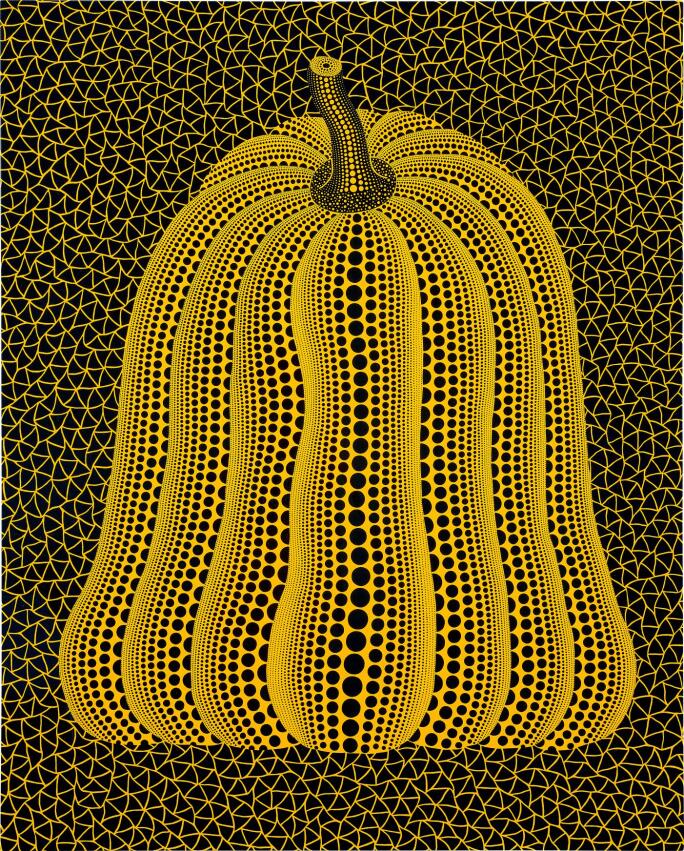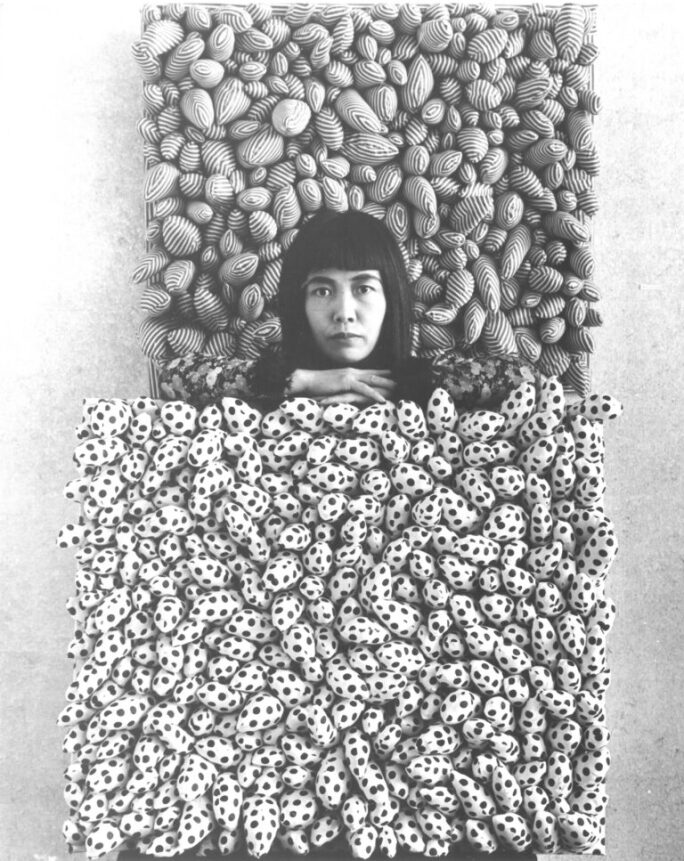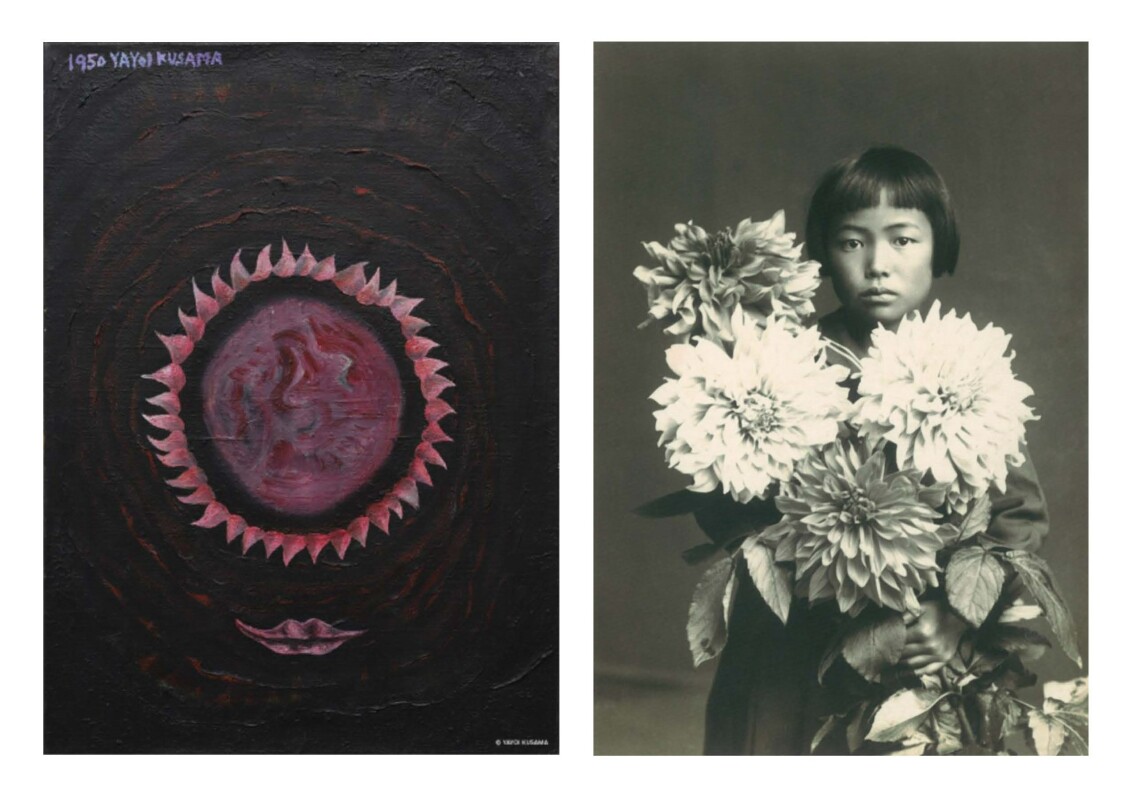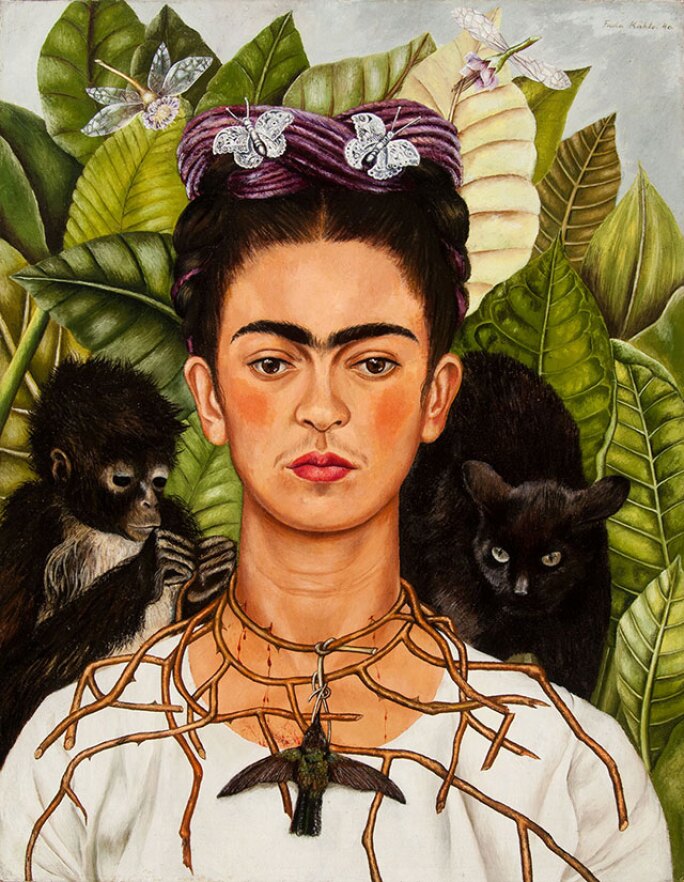“I think the earth is a dot, the moon is a dot, the sun is a dot, and the earth is only a dot among the countless planets in the universe. Polka dots are a way to infinity. When we obliterate nature and our bodies with polka dots, we become part of the unity of our environment. I become part of the eternal, and we obliterate ourselves in Love. ”
An exuberant and singularly iconic work, Yayoi Kusama’s Self-Portrait from 2015 epitomises the cosmic ascent of one the 21st century’s most distinguished artists. Rare, unique and historically significant, Self-Portrait was the first work to be displayed upon entering the artist’s celebrated 2022 exhibition at M+ Museum, Hong Kong, Kusama’s largest and most prestigious retrospective to date. Although hung first, Self-Portrait stood alone as the emotional crescendo of the artist’s seven decade career. Among a small number of self-portraits by the artist, Kusama is instantly recognisable by her blunt bobbed hair, dissolving into the expansive universe and infinite space of her eponymous patterning. Immersed by her most characteristic motifs - from polka dots, Infinity Nets, pumpkins and tubular forms - Self-Portrait is the first yellow and black frontal portrait in acrylic, the artist’s chosen medium since the 1980s, to ever have been offered at auction.

Executed in the artist’s signature black and yellow colour palette, a visual echo of her Pumpkin paintings and sculptures, Self-Portrait exudes a luminous quality, the bright yellow of the figure’s surface cutting through the shadowy blackness of Kusama’s all-over scaled tessellations. An iconic iteration of another of the artist’s instantly recognisable motifs, the surrounding net patterning is so dexterously rendered that the canvas hums with a rhythmic intensity. The distinctive texture of Kusama’s polka-dots flow and recede hypnotically, submerging the figure’s face and torso beneath the ever expanding and almost limitless multiplicity of the artist’s practise. Kusama’s career-long investigation into cosmic infinity and painterly preoccupation with the push and pull between pictorial and cosmic space can be acutely felt in the present work. Repetition, she explains, allows for a kind of release: “I make them and make them and keep on making them, until I bury myself in the process. I call this ‘obliteration’ (Yayoi Kusama, Infinity Net: The Autobiography of Yayoi Kusama, trans. Ralph McCarthy, London 2011, p. 47).

“How profound is the mystery of the infinity that is infinite across the cosmos. By perceiving this I want to see my own life. My life, a dot, namely, one among millions of particles.”

Photo © Marianne Dommisse
Artwork © YAYOI KUSAMA
Despite their rarity, there are numerous examples that corroborate the significance of self-portraiture with the artist’s oeuvre. Even those works which do not depict the artist can ultimately be described as about Kusama, with her depictions and installation of pumpkins widely seen as functioning as both an allegory and a form of self-portraiture for the artist. In a formal studio photograph from around 1939, Kusama, aged about ten, faces the camera holding a bouquet of dahlias, each flower as large as her head. Born in Nagano in 1929 to a family of seedling merchants, Kusama has frequently spoken of and imitated through her art the permeable boundary between the artist's self and her surroundings, an expression similarly conveyed in the 1950 work Self-Portrait. Amongst the earliest works to carry the title, Kusama portrays her face as a pink dot in the centre of the canvas, surrounded by wavering, petal-like motifs - a pair of lips the only discernible human feature. In depicting herself as a sunflower in this early work, Kusama was establishing a view that the body is not fixed to a particular form, that it can be transformed and remade in various guises. During her time in New York City in the 1960s, as she was creating her breakthrough series of Infinity Net paintings and Accumulation sculptures, Kusama’s portraiture and self-presentation expanded upon her signature philosophical notion of self-obliteration, as these works were often titled. Underlining her expansive vision of the universe shown in the Infinity and Accumulation series, Kusama began to fashion a private subjectivity whilst promoting a public image, a persona which has become one the most instantly recognisable in the world.

“By obliterating one’s individual self, one returns to the infinite universe”
Frequently the title of a Kusama work does not include a first-person pronoun but rather a generic third person, such as 'girl' or 'woman’, with these subjects often functioning or alluding to extensions, guises, or avatars of the artist. The archetypal figures in these paintings seem to be protected by flora and fauna-linking them back to the childhood photograph of Kusama surrounded by flowers, or engulfed and consumed by natural forces. Like Narcissus transformed into a garden of tiny flowers, Kusama disappears into another aspect of her manifold selves. Frontal images early in her career depict the point of merging between her vanished self and the object she became, most notably the flower. In later portraits, this would become a clearer transformation into a humanoid cat or monkey face. In recent years, a distinctive modality has emerged in the artist’s self-portraits that depict the artist squarely from the front, stoical yet bearing an emotional intensity. These works act as a symbolic substitute for the artist’s famed visage, hairstyle, and clothing as a composition of the artist's signature motifs, such as polka dots, Infinity Nets, pumpkins and the tubular forms found in the artist's earliest Accumulation sculptures. The present work typifies this late series of self-portraits, with Kusama shown submerging within the iconography and visual universe of her own work, becoming one with herself, the universe and her own artistic history over the last seven decades.

Collection of the Harry Ransom Center, Texas
© 2024 Banco de México Diego Rivera Frida Kahlo Museums Trust, Mexico, D.F. / Artists Rights Society (ARS), New York

© Artists Rights Society (ARS), New York
Self-portraiture is, of course, a well-established genre in art. In the visual lexicon of the last century, however, Kusama’s self-portraits find their equal with the most archetypal examples, which include those by artists who self-consciously portrayed themselves as revolutionaries resetting the course of the progress of art. Whilst Andy Warhol’s Marilyns, Elizabeth Taylors, self-portraits may be the most notorious of this kind, Kusama finds a closer comparison with Frida Khalo and Vincent van Gogh in terms of autographic and spiritual significance. What sets Kusama's self-portraits apart is that there is a strong sense that the self is present but on the verge of disappearing and transforming into another being, all at once. As psychoanalyst Juliet Mitchel describes, “Kusama's artworks show the oscillation, or even simultaneity, of her insistent, excessive presence either as herself as only an image of herself (often a photograph) or as some other object or image-an animal or a plant-and her obliteration of herself as a person” (Juliet Mitchell, ‘Portrait of the Artist as a Young Flower’, in Frances Morris, Ed. Yayoi Kusama, London 2012, pp. 192-197).
A glorious paradigm of Kusama’s legendary creative journey, Self-Portrait is magnificently emblematic of her radical, transformative and accomplished oeuvre. Embodying the iconic, charismatic and highly personal motifs which have become synonymous with the artist herself, Self-Portrait is a testament to decades of astonishing dedication to creation, technique, and a singular artistic vision. Vibrating with luminous energy, the Kusama of the present work is an amalgamation of the most-beloved pumpkin, the radical connectivity of the Infinity Nets series and the accumulated and expansive polka-dot pattern, submerging and emerging from a cosmic vision of her own making. Weaving together deeply imaginative iconography with a mediative exactitude, Kusama’s Self-Portrait is a consummate pinnacle of the career of one of the twenty-first century’s most iconic artists.
「我覺得地球是一個圓點,月亮是一個圓點,太陽是一個圓點,在宇宙無數的星球中,地球只是一個圓點。圓點能通往無限,當我們用圓點消融自然和身體,我們就變成這整個環境中的一分子。我們在『愛』裡消融自身的存在,成為永恆的一部分。」
《自 畫像》創作於2015年,洋溢熱情活力,是呈現草間彌生標誌性風格的矚目傑作,草間身為二十一世紀最傑出的藝術家之一,如今她心中感悟的宇宙變得更加宏闊,並完全體現在本作中。本作屬草間的少見之作,而且別具歷史意義。2022年,香港M+博物館為草間舉行至今規模最盛大的回顧展,本作正是觀眾步入展廳後見到的第一幅畫作。儘管本作是最先在展廳見到的作品,它卻代表著草間從藝七十多年來情感最充沛的創作。在草間為數不多的自畫像中,一頭齊耳短髮讓人馬上就認出她,整個人也融入於讓她有圓點女王之稱的廣闊圓點宇宙和無盡空間中。本作佈滿草間最具個人特色的主題,即是圓點、無限網、南瓜、軟管狀造型等等,雖然她早在上世紀八十年代開始選用壓克力創作,但這是第一次有草間以黄黑二色壓克力繪畫的正面肖像登上拍場。
本作採用了草間的標誌性黄黑二色,在視覺上呼應她的《南瓜》系列畫作和雕塑,畫中描繪的草間彷彿會發光似的,亮黃色穿透草間身後密鋪的黑色鱗片。作為草間另一個清晰易認的標誌性主題,人物周圍的無限網紋靈動細膩,讓畫面產生富有節奏感的律動。組成畫中人物獨特肌理的圓點圖案,猶如要將人催眠般流動後退,淹沒了她的臉和身體,隱藏在草間不斷擴展至近乎無盡的圖案中。本作展現了草間花了整個創作生涯專注研究的無垠宇宙,觀者可以從本作中感受到畫面和宇宙兩個空間在互相拉扯。她認為重複是釋放的方式,解釋道:「我不斷將圖案重複再重複,直至我完全沉浸在整個過程為止。我將之稱為『消融』。」(草間彌生:《無限網:草間彌生自傳》,拉爾夫・麥卡錫譯,倫敦,2011年,頁47)。
「宇宙洪荒中的神秘無限是多麼深奧。我想要透過這一感知來看到自己的人生。我的人生是億萬粒子中的一個圓點。」
雖然草間的自畫像為數不多,但有大量例子證明自畫像在草間的創作中十分重要。即使不是直接繪畫草間樣子的作品,最終也被認為是呈現草間的創作,因為南瓜畫作和裝置已經代表了她的形象,成為她表達自己的一種形式。在一張攝於1939年左右的影樓照片中,草間當時大約是十歲,她手持一束大麗菊,每朵大麗菊都跟她的臉一樣大。草間於1929年出生在日本長野縣的種苗商家庭,她經常談及自己的藝術,透過創作模仿自己與環境之間可以互相滲透的邊界,1950年她創作的《自畫像》就是呈現這種自己與背景融為一體的例子。在其中一幅以「自畫像」命名的早年作品中,草間在畫面中心將自己的臉畫成粉紅色圓點,臉周圍畫上類似花瓣的形狀,隨風搖曳,畫面只有兩片嘴唇是讓人認出是人臉的五官。就在草間將自己畫成向日葵的早年作品中,她意識到身體並不受限於特定的形狀,建立起身體可以改變和重塑成不同樣子的觀念。六十年代草間居於紐約期間,她創作突破性作品《無限網》畫作系列和《積累》軟雕塑系列同時,也利用自我消融的哲學概念,加以發展肖像畫和自我呈現的方式,並直接以自我消融命名這類作品。草間的《無限網》和《積累》系列突顯了她所見到的浩瀚宇宙,與此同時,她也開始形成一種私密的主觀意識展示對外形象,展現她如今最為世人所知的獨特造型。
「消除自我,就能回到無限的宇宙中。」
草間一般不會在作品標題運用第一人稱,反而會用像「女孩」和「女子」等的第三人稱,以這些主題明示或暗喻作品就是自己的自我延伸、變裝中的自己或者化身。她作品中的人物似乎可以得到植物和動物的保護,就像她小時候手持大麗菊拍的照片一樣,她被花朵包圍,被自然力量淹沒吞噬。就像開滿庭園的水仙花,草間消失在多重自我的其中一重。她在早期創作生涯繪畫的正面人像中,繪畫的是她消融的自我和所變成的事物之間如何融合,以她變成花朵的情況最為明顯。她其後創作的肖像畫更清楚顯示,畫中人變成人形貓或長了一張猴臉。近年,草間的自畫像出現了獨特的形式,正面描繪草間端正的模樣,一臉泰然,卻蘊含情感力量。這些作品成為取代草間形象、髮型和衣飾的象徵,畫面佈滿圓點、無限網、南瓜等標誌性主題,以及見於草間早期《積累》軟雕塑的軟管狀造型。本作是草間典型的晚年自畫像,畫中的草間被自己作品出現過的意象和所創作的無垠宇宙淹沒,與自己、宇宙和過去七十年的創作歷程融為一體。
自畫像固然是發展成熟的繪畫門類。然而,在上個世紀的視覺語彙中,草間的自畫像其實無異於當時最典型激進的畫像,例子包括由自覺是革新藝術發展進程分子的藝術家描繪的自畫像。安迪・沃荷筆下的瑪莉蓮・夢露、伊麗莎白・泰萊和自畫像也許是最為人所知的這一類畫像,但草間認為從演繹自我和精神意義的方面看,自己的創作更接近於芙烈達・卡蘿和文森・梵谷。草間的自畫像與眾不同之處,在於畫作展現出強烈的自我意識,自我卻在同一時間瀕臨消失邊緣,轉化成另一個物種。正如精神分析學家朱麗葉・米切爾所言:「不論草間的作品是關於她自己,或是她的形象(通常以照片出現),或是她作為其他物體,或是她變成動物或植物的形象,或是她作為自我已然消融的人,都流露出她持續過度展現的自我在搖擺不定,甚至同時出現多於一個的自我」(朱麗葉・米切爾,〈藝術家模仿小花的肖像〉,載法蘭西絲・莫里斯編,《草間彌生》,倫敦,2012年,頁192–197)。
本作是草間傳奇藝途上輝煌奪目的重要之作,象徵她不斷挑戰傳統並進化到至臻境界的修煉歷程。本作充滿草間的經典個人特色,魅力非凡,是舉世知名的代表作,反映數十年來她全情投入於創作和發展技法的心力,展現無比專注的藝術視野。畫中的草間綻放耀眼的光芒,融合了備受大家喜愛的南瓜、出自《無限網》系列緊密接連的紋理,以及不斷起伏擴展的圓點,就在自己創造的宇宙裡載浮載沉。本作將充滿想像力的意像與通過冥想展現的精準筆法交織融和,代表草間正值藝途巔峰時創作的圓滿之作。